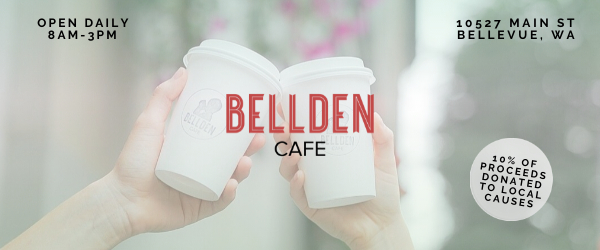Dear Lea,
So after visiting the ArtsFair this past weekend, I came to realize that there were actually 3 separate arts fairs going on in Downtown Bellevue. Do you know who sponsors each of the 3 fairs and why it isn’t just one big Bellevue arts fair? It’s a confusing message.
– Frazzeled by Fairs
Dear Frazzeled by Fairs,
It’s funny that you ask this question because I had the same one myself. It wasn’t until I went to the arts fairs last Friday that I realized that not only were there 3 different fairs, but that they weren’t connected to one other on a grander scale. Eager to find the answer to my questions, I tracked down a Bellevue Arts Museum information booth where I picked the brain of one of the volunteers. The Bellevue Arts Museum ArtsFair is put on by the Bellevue Arts Museum, and this year it was sponsored by Microsoft.
It is the longest running and most prominent arts event in the Northwest, with its first annual ArtsFair in 1947 presented by Bellevue Square. Over 350,000 visitors are speculated to have come to the ArtsFair over the weekend. This particular ArtsFair always occupies the west side of Bellevue Square from outside the mall, extending to the first level parking lots.
The second fair is the 6th Street Fair: A taste of the arts, which was literally on 6th Street and 106th Ave. This arts fair was put on by the Bellevue Downtown Association. It featured more than 120 artists and live musical entertainment.
Photo courtesy of B.A.M.
Photo courtesy of B.A.M.

The third fair is the Bellevue Festival of the Arts, which has been hosted in the Cost Plus World Market Parking lot for 24 years. It is put on and sponsored by the non-profit organization, Craft Cooporitive of the North West (CCNW). CCNW’s mission is to create a supportive and sustainable environment for artisits, while contributing to the community. They have donated the proceeds from their annual fair to those in need, such as Lifelong AIDS Alliance, local shelters and food banks, youth programs, and a rural teaching program in India.
Why they don’t just team up and form an alliance for one grand Bellevue Arts Fair, I don’t know. I assume it has something to do with the ultimate goals of each sponsor, profit versus not for profit, etc. I hope this clears it up for everyone because I agree with you that it’s a “confusing message.”
Dazzled by Fairs,
Lea
Have something YOU want to ASK? Write me at lea@downtownbellevue.com!













This is ridiculous.
Imagine if they combined their efforts into one, how much they would be able to accomplish.
One can only hope.
The different art fairs feature very different types of artists and craftspeople. The big museum fair is a juried event that brings in substantial talent from across the U.S. and Canada. It is very different from the fairs taking place across the street. My understanding is that they feature smaller local sellers offering perhaps a more affordable level of goods. People interested in one type of fair may not be so inclined to visit the other type. Never mind how huge the area would be that one would have to cover if it was a single fair.
Given that the art museum, the downtown association, and the craft cooperative with its associated charities all benefit from these events, it doesn’t problematic that there are three. No?
I understand the fairs have different types of artists, and crafts people, and pricepoints…but why not have one fair with different areas?
And then on top of that market the different areas, and communicate to people the differences.
The ArtsFair (which was established by PANACA – Pacific Northwest Arts and Crafts Association) many years before the Museum existed) is indeed distinct from the other fairs, much like the Edinburgh International Festival is different from the Fringe, and Broadway is different from Off-Broadway. All of the satellite events opperate in a parastic way – the fact that you’ve never heard of the other two Bellevue “fairs” shows how little promotion they do, in contrast to the extensive national promotion of ArtsFair. As someone else mentioned, ArtsFair is indeed juried – historically only about 25% of the applying artists get in. And the ArtsFair artist must indeed make the art (not re-market something made elsewhere) and must be present in the booth. And there is strict attention paid by the ArtsFair jury to ensure that a varied selection of art is presented. And all of the profits go to either the artists or the Museum – you have to acknowledge the tremendous generosity of Kemper Freeman who annually donates his facility and staff for the event. Really, what would the “real” fair have to gain by “partnering” with the other fairs?
I have heard of the different fairs, but just because of the Downtown Bellevue Network site.
Regular consumers just think there is one large fair going on. This matters, because you are saying how different the three fairs are…they are NOT getting credit for being different.
So either 1. Have them on different days (which I don’t think benefits anybody.) 2. Merge them into one large fair like everybody thinks of them already, and speak to the different areas separately. The fair can be organized by the existing (separate organizations, but there needs to be some collaboration on the different Fairs parts.
One person above made two good points and asked a good question. They said
1) “All of the satellite events opperate in a parastic way – the fact that you’ve never heard of the other two Bellevue ‘fairs’ shows how little promotion they do” and
2) “you have to acknowledge the tremendous generosity of Kemper Freeman who annually donates his facility and staff for the event.”
Both are very true. I think the other two fairs do take advantage of the fair at the mall and there is a lot that goes into making it happen in terms of cost. Kemper does benefit by getting more traffic to his properties, but that is beside the point.
The question posed was “Really, what would the ‘real’ fair have to gain by ‘partnering’ with the other fairs?”
I can see a few benefits.
A) Reduced advertising costs if the all fairs would share costs.
B) Better understanding and recognition of what each fair is.
C) More cohesive print materials and maps for all who visit the event.
I do think the three fairs should operate independently. I even like that they are in 3 different locations. However there are many economies of scale that would benefit all the fairs to some degree as well as the patrons. Why don’t they at least partner on advertising and event materials? Even the big fair would benefit from that. The only reason I can see they wouldn’t partner would be politics and bad feelings and that is a bad reason.